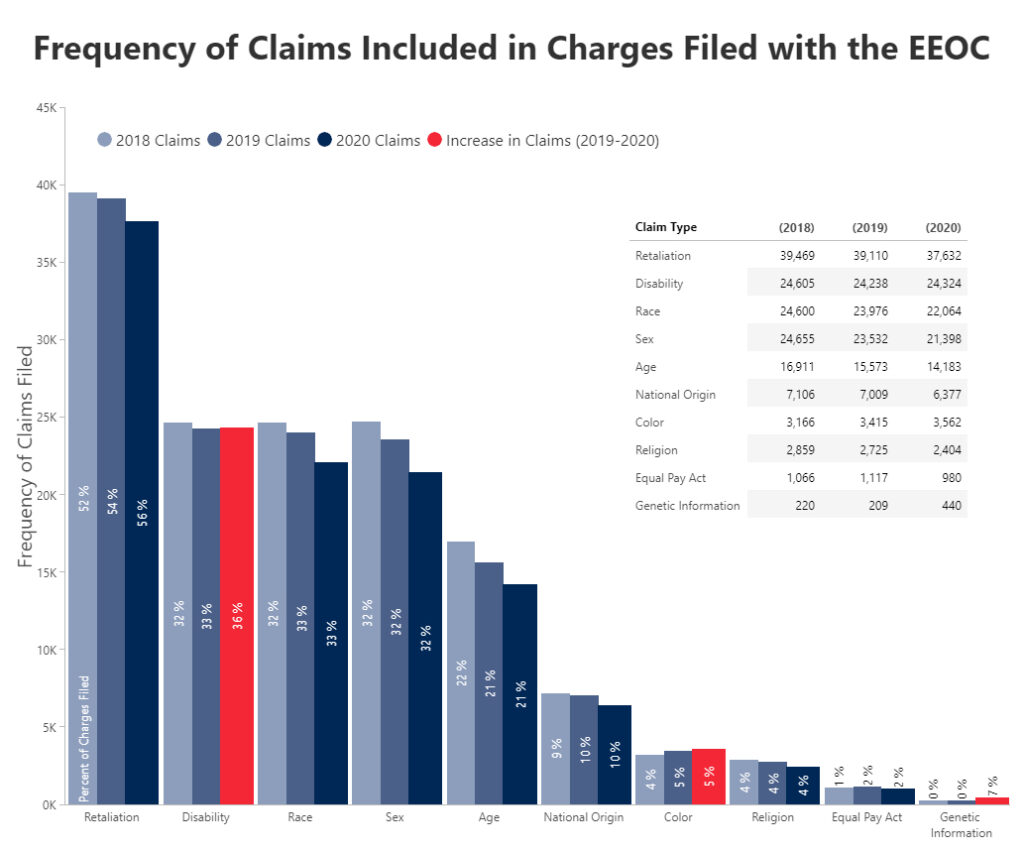What Employers Need to Know About the 2020 EEOC Charges Statistics and Insights Into What Employers Can Expect in 2021
By Katie Bayt and Jim Plunkett
As 2021 unfolds, employers might benefit from a glimpse into the U.S. Equal Employment Opportunity Commission (EEOC)—where it has been and where it is going. Beginning with a snapshot of the EEOC’s own fiscal year (FY) 2020 Enforcement and Litigation Statistics, which the agency released on February 26, 2021, our analysis of the data provides employers with a granular view into the agency’s enforcement efforts during the past year and offers some insights into what employers can expect going forward.
Seven Things to Know about Charges in 2020
1. Downward Trend in Number of Charges
FY2020 saw the lowest number of charges received from workers in more than two decades. The agency received 67,448 charges—less than the 72,675 charges the agency received in FY2019 and continuing the steady downward trend since 2017 in the numbers of discrimination charges filed with the EEOC.
2. Monetary Resolution of Charges
The agency touted securing $439.2 million for private sector claimants, including approximately $333.2 million through mediation, conciliation, and settlements of charges, and $106 million through litigation in FY2020, significantly overshadowing the $385 million it secured for claimants in FY2019 and $407 million in FY2018.
Despite increased recovery overall, monetary resolutions of charges decreased by $13.4 million, from $346.6 million in FY2019 down to $333.2 million.
3. Most Frequently Filed Claims
In FY2020, retaliation continued to be the most frequently filed claim included in charges with the EEOC—an astounding 55.8 percent of all charges filed included a retaliation claim, and it does not appear that trend will change any time soon. Categories of claims that showed a slight increase in frequency from FY2019 were disability and color discrimination, while genetic information claims saw over a two-fold increase from the prior year. Otherwise, the remaining categories all saw slight decreases from FY2019.
The breakdown, in descending order, of the frequency of claims filed in FY2020 are as follows:
- Retaliation: 37,632 claims (55.8 percent of charges filed)
- Disability: 24,324 (36.1 percent of charges filed)
- Race: 22,064 (32.7 percent of charges filed)
- Sex: 21,398 (31.7 percent of charges filed)
- Age: 14,183 (21.0 percent of charges filed)
- National Origin: 6,377 (9.5 percent of charges filed)
- Color: 3,562 (5.35 percent of charges filed)
- Religion: 2,404 (3.6 percent of charges filed)
- Equal Pay Act: 980 (1.5 percent of charges filed)
- Genetic Information: 440 (0.7 percent of charges filed)

4. Hot Topics
While COVID-19 significantly affected 2020 in many ways, the EEOC’s fiscal year 2020 statistics (which ran from October 1, 2019 through September 30, 2020) only encompassed data from approximately seven months of the pandemic. Recently, EEOC Chair Charlotte Burrows, newly appointed by President Joe Biden, emphasized her view that the pandemic is not only a health and economic crisis, but also a civil rights crisis. As noted above, during FY2020 claims of disability discrimination saw a small uptick in frequency as compared to FY2019, while genetic information claims saw a considerable increase. Charges that included claims of discrimination based on color also increased slightly.
On the other hand, national origin and race discrimination claims showed a slight decrease in frequency from FY2019 despite concerns related to discrimination against Asian Americans and people of Asian descent in the workplace during the pandemic and the larger context of social justice issues that came to the forefront during 2020. The full impact of the pandemic and the social justice movement remains to be seen and a combined review of FY2020 stats with next year’s enforcement data will likely help shed additional light on the impact of these issues on charges filed with the EEOC.
Also of note, despite the continued focus on sexual harassment issues in the workplace—or perhaps because of steps many employers are taking to address these issues—the number of sexual harassment claims filed dropped to 6,587, down from 7,514 filed in FY2019. Similarly, the amount of recovery through settlements relating to sexual harassment claims dropped from $68.2 million in FY2019 to $65.3 million in FY2020.
5. Pending Charges
Reducing its backlog of pending private-sector charge inventory continued to be an area of focus for the EEOC in FY2020. Pending charges again decreased in FY2020, this year by 3.7 percent to 41,951 charges—the lowest in 14 years.
6. Mediations
For FY2020, during part of which the EEOC utilized a mediation pilot program that expanded opportunities for mediation and incorporated video technology for virtual mediation, the EEOC reported that it achieved 6,272 successful private sector mediations resulting in over $156.6 million to claimants—slightly less than $159 million in FY2019.
7. Charges by State
Once again, in 2020, more charges were filed in Texas than any other state, with 6,876, and Florida came in second with 5,868. Pennsylvania followed in third with 4,599. The visualization below shows by state where claimants filed most frequently in 2020.

Going Forward in 2021
The current EEOC is fully staffed with five commissioners, all of whom were appointed by former president Donald Trump. There are three Republicans: former chair Janet Dhillon, Keith Sonderling, and Andrea Lucas. Dhillon’s term does not end until July 1, 2022, while Sonderling’s and Lucas’s terms extend to 2024 and 2025, respectively. This means that the three Republican commissioners will outnumber Democratic commissioners until at least July 2022. The two Democrats on the EEOC are Chair Burrows and Vice Chair Jocelyn Samuels.
As chair, Burrows sets the policy agenda, but it is still unclear what this will look like. For example, what are Burrows’s plans for the 2017 proposed harassment guidance that has never been finalized? What will happen with employer-sponsored wellness programs, in light of the fact that the EEOC’s recent regulatory proposals addressing such programs were withdrawn? And, what about compensation discrimination and wage data collection? Stakeholders are anxious to learn what issues Burrows will prioritize and where the EEOC will head under her leadership.
While Burrows sets the agenda, actually executing policy initiatives could prove difficult when considering the EEOC’s current political demographics. The EEOC’s authority is primarily derived from the commissioners, and Burrows simply does not have the votes. To be sure, the EEOC and its commissioners are obviously more than their party affiliation, and there are previous examples of commissioner bipartisanship on big-ticket items. So with a chair setting the policy agenda but lacking the votes, what will this mean? Does this present an opportunity for bipartisanship or more gridlock? Regardless, this “upside down” commission—where the chair and vice chair are in the political minority—will likely be the political situation at the EEOC until at least July 2022. Despite these uncertainties, there are, however, some areas where there could be bi-partisan support, such as veterans outreach, guidance on COVID-19 and workplace protections, continuation of transparency efforts, continuation of robust enforcement and of efforts to reduce pending charge loads.
Ogletree Deakins’ EEO Advantage Administrative Charges Program helps employers manage their administrative charges filed with federal, state, and local agencies nationwide. EEO Advantage leverages technology and a thorough understanding of agency processes to manage administrative charges proactively and with budget certainty.

of counsel and director
Ogletree Deakins EEO Advantage Administrative Charges Program
katie.bayt@ogletree.com

shareholder and chair of Ogletree Governmental Affairs
james.plunkett@ogletree.com.
